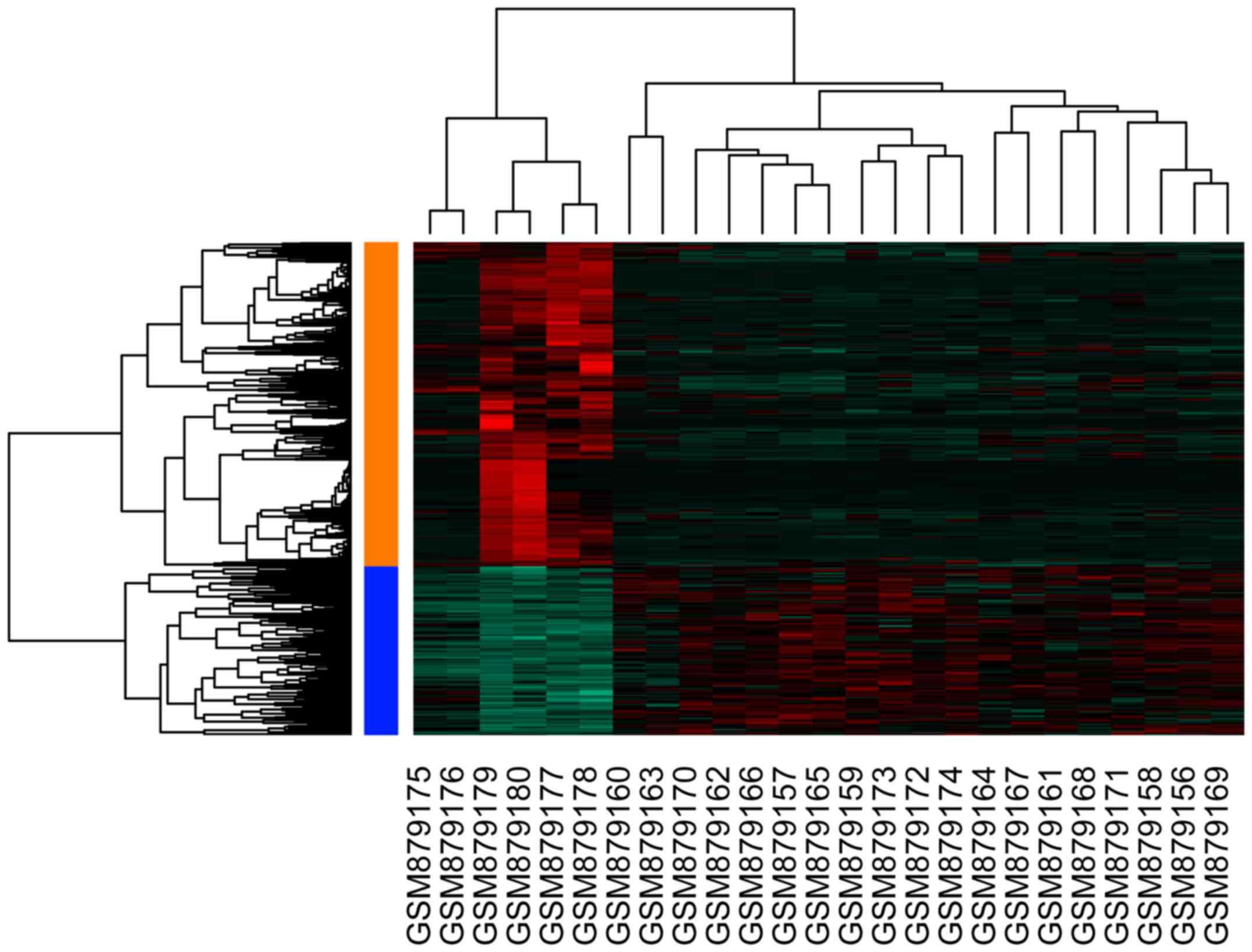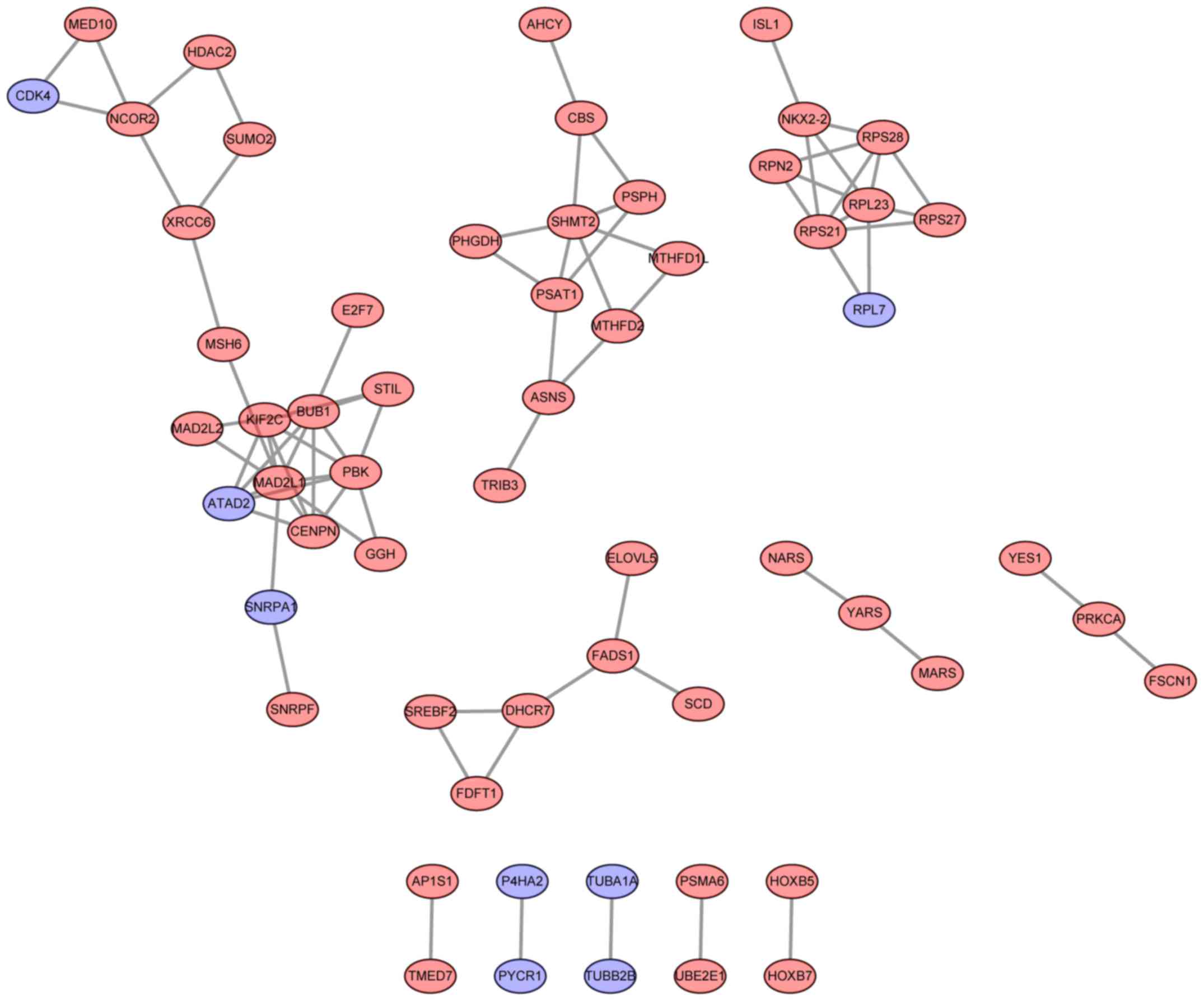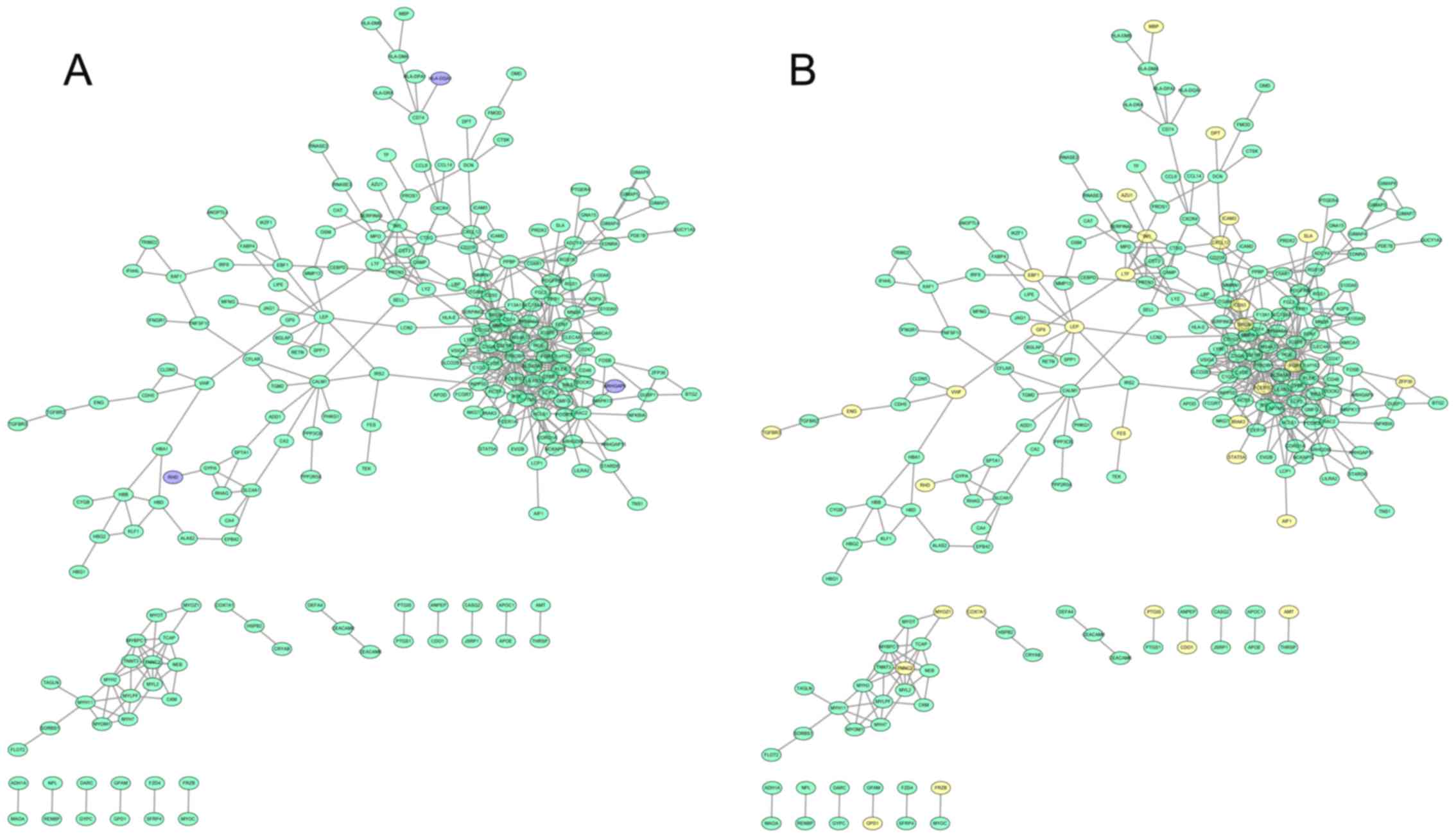|
1
|
Ottaviani G and Jaffe N: The epidemiology
of osteosarcoma. In: Pediatric and Adolescent Osteosarcoma. Jaffe
N, Bruland OS and Bielack S: Springer; New York: pp. 3–13. 2010
|
|
2
|
Posthuma De, Boer J, Witlox MA, Kaspers GJ
and van Royen BJ: Molecular alterations as target for therapy in
metastatic osteosarcoma: A review of literature. Clin Exp
Metastasis. 28:493–503. 2011. View Article : Google Scholar : PubMed/NCBI
|
|
3
|
Aksnes LH, Hall KS, Folleraas G, Stenwig
AE, Bjerkehagen B, Taksdal I, Winderen M, Bruland OS and Saeter G:
Management of high-grade bone sarcomas over two decades: The
Norwegian Radium Hospital experience. Acta Oncol. 45:38–46. 2006.
View Article : Google Scholar : PubMed/NCBI
|
|
4
|
Sakamoto A and Iwamoto Y: Current status
and perspectives regarding the treatment of osteosarcoma:
Chemotherapy. Rev Recent Clin Trials. 3:228–231. 2008. View Article : Google Scholar : PubMed/NCBI
|
|
5
|
Sadikovic B, Thorner P, Chilton-MacNeill
S, Martin JW, Cervigne NK, Squire J and Zielenska M: Expression
analysis of genes associated with human osteosarcoma tumors shows
correlation of RUNX2 overexpression with poor response to
chemotherapy. Bmc Cancer. 10:2022010. View Article : Google Scholar : PubMed/NCBI
|
|
6
|
Smida J, Baumhoer D, Rosemann M, Walch A,
Bielack S, Poremba C, Remberger K, Korsching E, Scheurlen W,
Dierkes C, et al: Genomic alterations and allelic imbalances are
strong prognostic predictors in osteosarcoma. Clin Cancer Res.
16:4256–4267. 2010. View Article : Google Scholar : PubMed/NCBI
|
|
7
|
Squire JA, Pei J, Marrano P, Beheshti B,
Bayani J, Lim G, Moldovan L and Zielenska M: High-resolution
mapping of amplifications and deletions in pediatric osteosarcoma
by use of CGH analysis of cDNA microarrays. Genes Chromosomes
Cancer. 38:215–225. 2003. View Article : Google Scholar : PubMed/NCBI
|
|
8
|
Sandberg AA and Bridge JA: Updates on the
cytogenetics and molecular genetics of bone and soft tissue tumors:
Osteosarcoma and related tumors. Cancer Genet Cytogenet. 145:1–30.
2003. View Article : Google Scholar : PubMed/NCBI
|
|
9
|
Cui J, Wang W, Li Z, Zhang Z, Wu B and
Zeng L: Epigenetic changes in osteosarcoma. Bull Cancer.
98:E62–E68. 2011.PubMed/NCBI
|
|
10
|
Momparler RL and Bovenzi V: DNA
methylation and cancer. J Cell Physiol. 183:145–154. 2000.
View Article : Google Scholar : PubMed/NCBI
|
|
11
|
Hou P, Ji M, Yang B, Chen Z, Qiu J, Shi X
and Lu Z: Quantitative analysis of promoter hypermethylation in
multiple genes in osteosarcoma. Cancer. 106:1602–1609. 2006.
View Article : Google Scholar : PubMed/NCBI
|
|
12
|
Lim S, Yang MH, Park JH, Nojima T,
Hashimoto H, Unni KK and Park YK: Inactivation of the RASSF1A in
osteosarcoma. Oncol Rep. 10:897–901. 2003.PubMed/NCBI
|
|
13
|
Rathi A, Virmani AK, Harada K, Timmons CF,
Miyajima K, Hay RJ, Mastrangelo D, Maitra A, Tomlinson GE and
Gazdar AF: Aberrant methylation of the HIC1 promoter is a frequent
event in specific pediatric neoplasms. Clin Cancer Res.
9:3674–3678. 2003.PubMed/NCBI
|
|
14
|
Batra J, Srinivasan S and Clements J:
Single Nucleotide Polymorphisms (SNPs). In: Molecular Testing in
Cancer. Springer. Yousef GM and Jothy S: Springer Science and
Buisiness Media. (New York, NY). 55–80. 2014.
|
|
15
|
Gokgoz N, Wunder JS and Andrulis IL:
Abstract 5075: Genome-wide analysis of DNA copy number variations
in osteosarcoma. Cancer Res. 72:50752012. View Article : Google Scholar
|
|
16
|
Seidinger AL, Mastellaro MJ, Paschoal
Fortes F, Godoy Assumpção J, Aparecida Cardinalli I, Aparecida
Ganazza M, Correa Ribeiro R, Brandalise SR, Dos Santos Aguiar S and
Yunes JA: Association of the highly prevalent TP53 R337H mutation
with pediatric choroid plexus carcinoma and osteosarcoma in
southeast Brazil. Cancer. 117:2228–2235. 2011. View Article : Google Scholar : PubMed/NCBI
|
|
17
|
Fu HL, Shao L, Wang Q, Jia T, Li M and
Yang DP: A systematic review of p53 as a biomarker of survival in
patients with osteosarcoma. Tumour Biol. 34:3817–3821. 2013.
View Article : Google Scholar : PubMed/NCBI
|
|
18
|
Yen CC, Chen WM, Chen TH, Chen WY, Chen
PC, Chiou HJ, Hung GY, Wu HT, Wei CJ, Shiau CY, et al:
Identification of chromosomal aberrations associated with disease
progression and a novel 3q13.31 deletion involving LSAMP gene in
osteosarcoma. Int J Oncol. 35:775–788. 2009.PubMed/NCBI
|
|
19
|
Lockwood WW, Stack D, Morris T, Grehan D,
O'Keane C, Stewart GL, Cumiskey J, Lam WL, Squire JA, Thomas DM and
O'Sullivan MJ: Cyclin E1 is amplified and overexpressed in
osteosarcoma. J Mol Diagn. 13:289–296. 2011. View Article : Google Scholar : PubMed/NCBI
|
|
20
|
Kresse SH, Rydbeck H, Skårn M, Namløs HM,
Barragan-Polania AH, Cleton-Jansen AM, Serra M, Liestøl K,
Hogendoorn PC, Hovig E, et al: Integrative analysis reveals
relationships of genetic and epigenetic alterations in
osteosarcoma. PLoS One. 7:e482622012. View Article : Google Scholar : PubMed/NCBI
|
|
21
|
Barrett T, Wilhite SE, Ledoux P,
Evangelista C, Kim IF, Tomashevsky M, Marshall KA, Phillippy KH,
Sherman PM, Holko M, et al: NCBI GEO: Archive for functional
genomics data sets-update. Nucleic Acids Res. 41:D991–D995. 2013.
View Article : Google Scholar : PubMed/NCBI
|
|
22
|
Smyth GK: Limma: Linear models for
microarray data. Bioinformatics and Computational Biology Solutions
Using R and Bioconductor. Gentleman R, Vincent JC, Huber W,
Irizarry RA and Dudolt S: Springer; pp. 397–420. 2005, View Article : Google Scholar
|
|
23
|
Gentleman RC, Carey VJ, Bates DM, Bolstad
B, Dettling M, Dudoit S, Ellis B, Gautier L, Ge Y, Gentry J, et al:
Bioconductor: Open software development for computational biology
and bioinformatics. Genome Biol. 5:R802004. View Article : Google Scholar : PubMed/NCBI
|
|
24
|
Benjamini Y and Hochberg Y: Controlling
the false discovery rate: A practical and powerful approach to
multiple testing. J Royal Stat Soc. 57:289–300. 1995.
|
|
25
|
RC ore Team: R, . A language and
environment for statistical computing. R Foundation for Statistical
Computing (Vienna, Austria). 2013.
|
|
26
|
Du P, Kibbe WA and Lin SM: Lumi: A
pipeline for processing Illumina microarray. Bioinformatics.
24:1547–1548. 2008. View Article : Google Scholar : PubMed/NCBI
|
|
27
|
Du P and Bourgon R: methyAnalysis: An R
package for DNA methylation data analysis and visualization.
2013.
|
|
28
|
Scharpf RB, Irizarry RA, Ritchie ME,
Carvalho B and Ruczinski I: Using the R package crlmm for
genotyping and copy number estimation. J Stat Softw. 40:1–32. 2011.
View Article : Google Scholar : PubMed/NCBI
|
|
29
|
Venkatraman E and Seshan A: DNAcopy: DNA
copy number data analysis. R Package Version. 1:2010.
|
|
30
|
Ashburner M, Ball CA, Blake JA, Botstein
D, Butler H, Cherry JM, Davis AP, Dolinski K, Dwight SS, Eppig JT,
et al: Gene ontology: Tool for the unification of biology. The Gene
Ontology Consortium. Nat Genet. 25:25–29. 2000. View Article : Google Scholar : PubMed/NCBI
|
|
31
|
Kanehisa M and Goto S: KEGG: Kyoto
encyclopedia of genes and genomes. Nucleic Acids Res. 28:27–30.
2000. View Article : Google Scholar : PubMed/NCBI
|
|
32
|
Huang DW, Sherman BT, Tan Q, Collins JR,
Alvord WG, Roayaei J, Stephens R, Baseler MW, Lane HC and Lempicki
RA: The DAVID gene functional classification tool: A novel
biological module-centric algorithm to functionally analyze large
gene lists. Genome Biol. 8:R1832007. View Article : Google Scholar : PubMed/NCBI
|
|
33
|
Von Mering C, Huynen M, Jaeggi D, Schmidt
S, Bork P and Snel B: STRING: A database of predicted functional
associations between proteins. Nucleic Acids Res. 31:258–261. 2003.
View Article : Google Scholar : PubMed/NCBI
|
|
34
|
Kohl M, Wiese S and Warscheid B:
Cytoscape: Software for visualization and analysis of biological
networks. Methods Mol Biol. 696:291–303. 2011. View Article : Google Scholar : PubMed/NCBI
|
|
35
|
Rahman M and Zhang Q: Comparison among
pearson correlation coefficient tests. Far East J Math Sci (FJMS).
99:237–255. 2016. View Article : Google Scholar
|
|
36
|
Mohseny AB, Machado I, Cai Y, Schaefer KL,
Serra M, Hogendoorn PC, Llombart-Bosch A and Cleton-Jansen AM:
Functional characterization of osteosarcoma cell lines provides
representative models to study the human disease. Lab Invest.
91:1195–1205. 2011. View Article : Google Scholar : PubMed/NCBI
|
|
37
|
Novak N, Tepel C, Koch S, Brix K, Bieber T
and Kraft S: Evidence for a differential expression of the
FcepsilonRIgamma chain in dendritic cells of atopic and nonatopic
donors. J Clin Invest. 111:1047–1056. 2003. View Article : Google Scholar : PubMed/NCBI
|
|
38
|
Liang Y, Wang P, Zhao M, Liang G, Yin H,
Zhang G, Wen H and Lu Q: Demethylation of the FCER1G promoter leads
to FcεRI overexpression on monocytes of patients with atopic
dermatitis. Allergy. 67:424–430. 2012. View Article : Google Scholar : PubMed/NCBI
|
|
39
|
Ellis L, Atadja PW and Johnstone RW:
Epigenetics in cancer: Targeting chromatin modifications. Mol
Cancer Ther. 8:1409–1420. 2009. View Article : Google Scholar : PubMed/NCBI
|
|
40
|
Reseland JE, Syversen U, Bakke I, Qvigstad
G, Eide LG, Hjertner O, Gordeladze JO and Drevon CA: Leptin is
expressed in and secreted from primary cultures of human
osteoblasts and promotes bone mineralization. J Bone Miner Res.
16:1426–1433. 2001. View Article : Google Scholar : PubMed/NCBI
|
|
41
|
Burguera B, Brunetto A, Garcia-Ocana A,
Teijeiro R, Esplen J, Thomas T, Couce ME and Zhao A: Leptin
increases proliferation of human steosarcoma cells through
activation of PI(3)-K and MAPK pathways. Med Sci Monit.
12:BR341–BR349. 2006.PubMed/NCBI
|
|
42
|
Tronick SR, Popescu NC, Cheah MS, Swan DC,
Amsbaugh SC, Lengel CR, DiPaolo JA and Robbins KC: Isolation and
chromosomal localization of the human fgr protooncogene, a distinct
member of the tyrosine kinase gene family. Proc Natl Acad Sci USA.
82:6595–6599. 1985. View Article : Google Scholar : PubMed/NCBI
|
|
43
|
Perissinotto E, Cavalloni G, Leone F,
Fonsato V, Mitola S, Grignani G, Surrenti N, Sangiolo D, Bussolino
F, Piacibello W and Aglietta M: Involvement of chemokine receptor
4/stromal cell-derived factor 1 system during osteosarcoma tumor
progression. Clin Cancer Res. 11:490–497. 2005.PubMed/NCBI
|
|
44
|
Pasic I, Shlien A, Durbin AD, Stavropoulos
DJ, Baskin B, Ray PN, Novokmet A and Malkin D: Recurrent focal
copy-number changes and loss of heterozygosity implicate two
noncoding RNAs and one tumor suppressor gene at chromosome 3q13.31
in osteosarcoma. Cancer Res. 70:160–171. 2010. View Article : Google Scholar : PubMed/NCBI
|
|
45
|
Ang BK, Lim CY, Koh SS, Sivakumar N, Taib
S, Lim KB, Ahmed S, Rajagopal G and Ong SH: ArhGAP9, a novel MAP
kinase docking protein, inhibits Erk and p38 activation through WW
domain binding. J Mol Signal. 2:12007. View Article : Google Scholar : PubMed/NCBI
|
|
46
|
Bonito NA, Drechsler J, Stoecker S, Carmo
CR, Seckl MJ, Hermanns HM and Costa-Pereira AP: Control of gp130
expression by the mitogen-activated protein kinase ERK2. Oncogene.
33:2255–2263. 2014. View Article : Google Scholar : PubMed/NCBI
|
|
47
|
Luo Y, Deng Z and Chen J: Pivotal
regulatory network and genes in osteosarcoma. Arch Med Sci.
9:569–575. 2013. View Article : Google Scholar : PubMed/NCBI
|
|
48
|
Endo-Munoz L, Cumming A, Sommerville S,
Dickinson I and Saunders NA: Osteosarcoma is characterised by
reduced expression of markers of osteoclastogenesis and antigen
presentation compared with normal bone. Br J Cancer. 103:73–81.
2010. View Article : Google Scholar : PubMed/NCBI
|
|
49
|
Ciró M, Prosperini E, Quarto M, Grazini U,
Walfridsson J, McBlane F, Nucifero P, Pacchiana G, Capra M,
Christensen J and Helin K: ATAD2 is a novel cofactor for MYC,
overexpressed and amplified in aggressive tumors. Cancer Res.
69:8491–8498. 2009. View Article : Google Scholar : PubMed/NCBI
|
|
50
|
Swingler TE, Wheeler G, Carmont V, Elliott
HR, Barter MJ, Abu-Elmagd M, Donell ST, Boot-Handford RP,
Hajihosseini MK, Münsterberg A, et al: The expression and function
of microRNAs in chondrogenesis and osteoarthritis. Arthritis Rheum.
64:1909–1919. 2012. View Article : Google Scholar : PubMed/NCBI
|
|
51
|
Fellenberg J, Bernd L, Delling G, Witte D
and Zahlten-Hinguranage A: Prognostic significance of
drug-regulated genes in high-grade osteosarcoma. Mod Pathol.
20:1085–1094. 2007. View Article : Google Scholar : PubMed/NCBI
|
|
52
|
Kyriazoglou AI, Vieira J, Dimitriadis E,
Arnogiannaki N, Teixeira MR and Pandis N: 12q amplification defines
a subtype of extraskeletal osteosarcoma with good prognosis that is
the soft tissue homologue of parosteal osteosarcoma. Cancer Genet.
205:332–336. 2012. View Article : Google Scholar : PubMed/NCBI
|
|
53
|
Mejia-Guerrero S, Quejada M, Gokgoz N,
Gill M, Parkes RK, Wunder JS and Andrulis IL: Characterization of
the 12q15 MDM2 and 12q13-14 CDK4 amplicons and clinical
correlations in osteosarcoma. Genes Chromosomes Cancer. 49:518–525.
2010.PubMed/NCBI
|
|
54
|
Finn RS, Crown JP, Lang I, Boer K,
Bondarenko IM, Kulyk SO, Ettl J, Patel R, Pinter T, Schmidt M, et
al: Abstract S1-6: Results of a randomized phase 2 study of PD
0332991, a cyclin-dependent kinase (CDK) 4/6 inhibitor, in
combination with letrozole vs. letrozole alone for first-line
treatment of ER+/HER2-advanced breast cancer (BC). Cancer Res.
72:(24 Suppl). S1–S6. 2012. View Article : Google Scholar
|

















